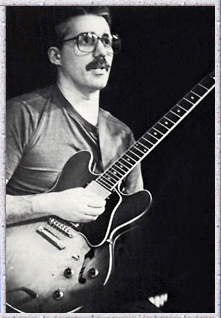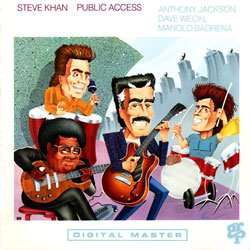Steve Khan's "Mambosa"(Khan)
Lead sheet
I don't believe that I had actually sat down and listened to "Mambosa" from the "PUBLIC ACCESS" CD('89) in 10 years or more! But, when I did, I was reminded of many wonderful things. Great memories of those recording sessions, the rehearsals, and making music with Anthony Jackson; Dave Weckl; and Manolo Badrena. This tune actually began as something I was only 'fooling around with' on my now archaic Yamaha DX-7. Because there was a keyboard part, integral to the piece, I in no way imagined that it would fit within the Eyewitness concept. But, as I was preparing the music for the recording, and knowing the then 'new' CD format would give us much more time, I decided that it would be great for us. And if, I programmed the sequence with enough estimated space for soloing, we could be ourselves and play along with the keyboard part 'live.' And this is exactly what we did. And if, I programmed the sequence with enough estimated space for soloing, we could be ourselves and play along with the keyboard part 'live.' And this is exactly what we did.
I could not have done any of this without the help of two old and dear friends: [1] guitarist/arranger, Al Gorgoni and his Lightstream Studio here in New York City; and [2] his eldest son, Adam Gorgoni, who has now gone on to a great career scoring films in Los Angeles. In the end, it was Adam who helped me prepare the keyboard sequence, which we used to play against while recording. Perhaps the greatest influence on this very simple whole-note 'pad'-oriented type of accompaniment is my dear friend, Don Grolnick. During the '70s, when others were playing tons and tons of notes, rhythmically speaking, as 'accompaniment,' Don went the other way, and played less, offering the soloist these big beautiful pillows of harmony to float over. He was very special to have playing behind you. The other influence, which crept into this keyboard part, is Herbie Hancock and his tune "Butterfly" from "THRUST." However, this 'influence' is very brief and only appears in the 4th bar of letter [C] with the 3rds that color the descending melodic notes. Those of you who are fans of Herbie's tune should immediately know the moment of which I am speaking.
Of course, at the time, I had no idea that I was actually composing a cha-cha. I was simply going on instinct, which sometimes is the best thing to do. I remember that when we were laying down the keyboard part on the multi-track machine, I suddenly asked Manolo if he could play the güiro on it. Of course, Manolo must be the only Puerto Rican percussionist who doesn't travel with a güiro in his immense bag of tricks. So, he ended-up having to use a guicharo which is better suited for a bomba. And then, of course, he didn't have the proper stick, so we had to improvise something, and I can't remember what we found laying around. It might have even been a plastic fork!!! How disgraceful.....but, typically comical!!! How strange life is, if I had then been the güirocero that I have now become, I would have done it myself!!!
The [A] melody section is really comprised of 4 individual melodic phrases, and each is separated by 4 bars of the basic keyboard vamp. So, in bars 5-8; 13-16; and 21-24 you hear a 2nd keyboard part enter with a little melodic idea played in 3rds. It is an almost childishly simple melody, but one usually attains the best results by relying on what they hear and keeping things simple. Complex is NOT always best!!! I remember when I was playing this part into the sequencer, Adam and I used to laugh because I always referred to it as "the little ice cream truck." I guess it reminded me of what I wish the "Good Humor" ice cream man's truck would have sounded like when I was a little kid in West Los Angeles.
As a piece of music, this tune uses a couple of very familiar compositional and structural devices. With [A] being written over an F7(9/13) sonority, it simply felt right to go up a half-step to variations on an C#m7(9)/F# sound for [B]. However, when we arrive at [C] and we come back down that half-step, we now arrive at an Fmaj7(9) sonority instead the anticipated dominant 7th sound. As this section concludes, we cadence to the basic vamp, but it is in F#7(9/13), and with a clever little 'break' line, we finally come back down that half-step, and we're back to our F7(9/13).
The lead sheet we are presenting here at Korner 2, really only outlines the basic sections of the piece and does not provide the full 'road map' of the performance structure. So below, I have provided the 'alphabet soup' version of how "Mambosa" was performed on the recording. If you sketch out these letter names for yourself, you should be able to follow along.
[I] Intro
[A]
[B] Vamp - 4 bars
[B2] 2x
[C]
[D] Guitar solo over [A] groove
[B] Vamp - 4 bars
[E] Percussion solo over [B2] groove
[B3] Melodic fragments from [B2]
[B2] 1x
[C]
[A]
[Fade]
For the percussion solo at [E] which is played over the basic groove for letter [B], I decided to pre-program, using the 2nd keyboard part, melodic fragments from [B2]. I only play bars 1-2 and 5-6 of the [B2] melody as Manolo is soloing leaving the others bars open. I felt that this would supply us with a musical lift to help give the solo section a sense of direction, and it would also serve as a 'cue' for Anthony, Dave and me so that we would know exactly how many bars were left before we had to move on and eventually actually play the full melody to [B2] as Manolo concludes. Then we went ahead and played [C]. for Anthony, Dave and me so that we would know exactly how many bars were left before we had to move on and eventually actually play the full melody to [B2] as Manolo concludes. Then we went ahead and played [C].
During the FADE, you can hear one my favorite personal moments on this tune. Just as we begin to pull the 'fader' down I began to play something with the help of my KORG DVP-1 harmonizer which, once again, brought in my 'mini guitar big band.' And though I have mentioned this unit before, the idea for this sound came from working with Joe Zawinul as part of Weather Update in '86. Joe used to do something very similar with his "Prophet 5" keyboard and he was kind enough to explain the 'unison lock' feature which seems to 'capture' a just-played voicing, and then, once it has been pressed in, everything you play is that voicing in parallel. As all my voicings are set-up in the DVP-1 so that the note I play on my guitar is always the top voice. For this one moment in the tune, I chose to use a program which was set to: [-3] [-5] [-8] with those degrees referring to the half-steps down from the note I'm playing. Remember that we are just improvising over an F7(9/13) sound. If you have a harmonizer in your rack, give this one a try.
It would be a dream for me if, someday, a Latin-style big band decided to arrange, record and perform this strange little cha-cha of mine. Wow! That would be a great thrill and an honor. And so, for the month of April, as we all sing: "Happy Birthday to me!!!" know that Blaine and I are wishing everyone a joyous springtime full of the bloom of wondrous things to come. Actually, at this age I think that it is far better to go the "Alice in Wonderland" route and sing: "A very merry unbirthday to me, to me!!!"
[Photo of Steve by David Tan, at American Sound Rehearsal Studios.]
|


 for Anthony, Dave and me so that we would know exactly how many bars were left before we had to move on and eventually actually play the full melody to [B2] as Manolo concludes. Then we went ahead and played [C].
for Anthony, Dave and me so that we would know exactly how many bars were left before we had to move on and eventually actually play the full melody to [B2] as Manolo concludes. Then we went ahead and played [C].